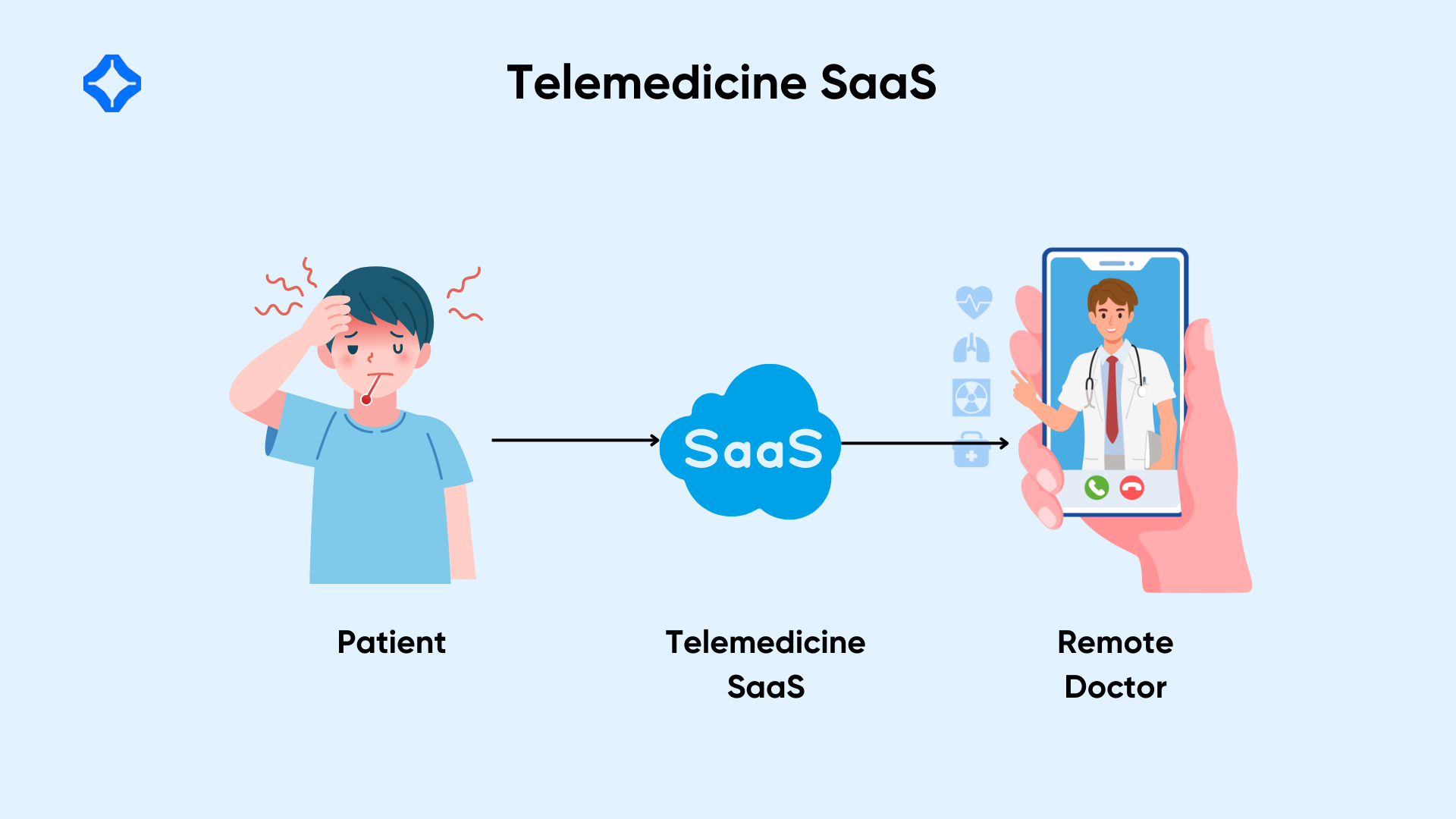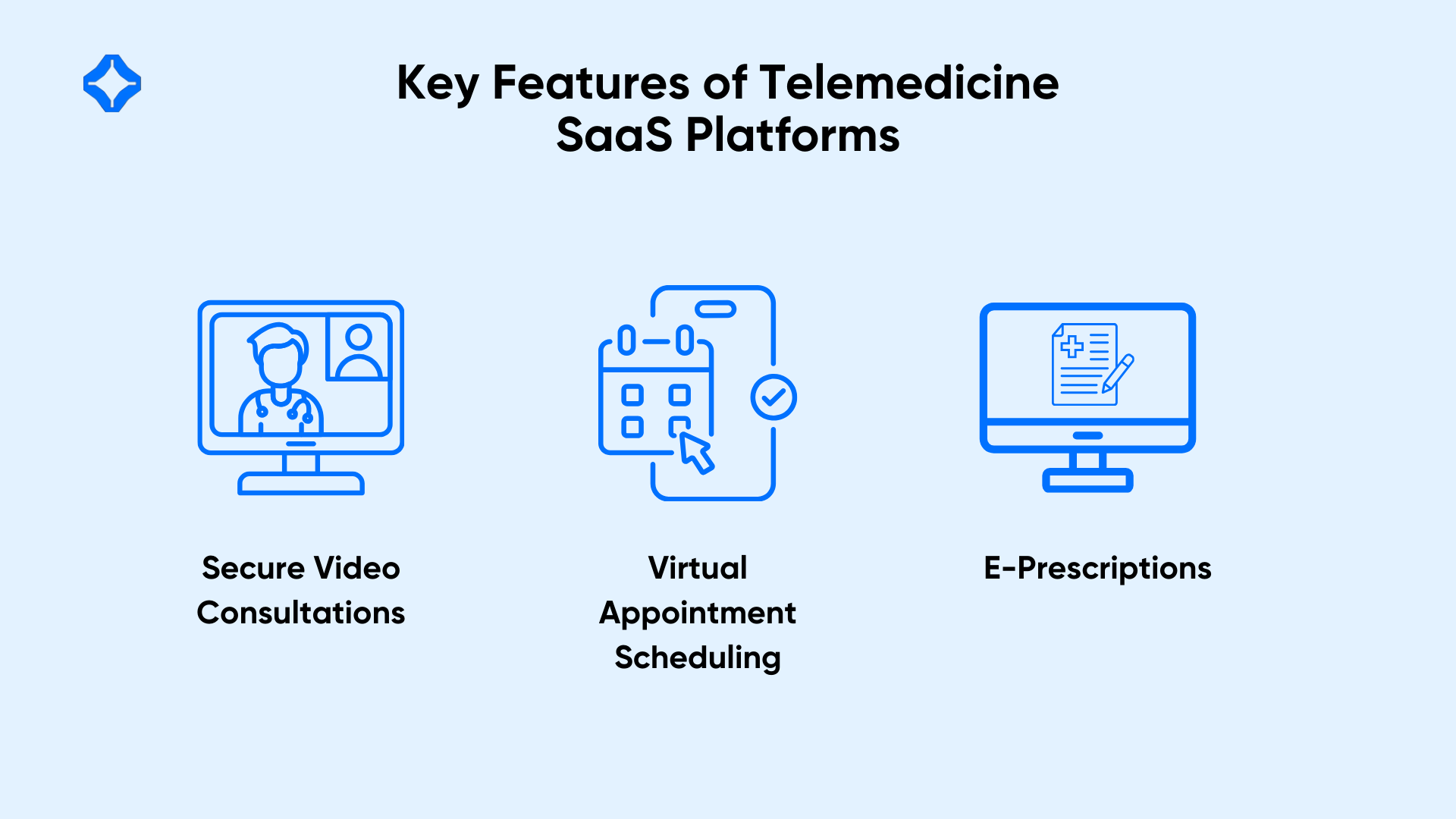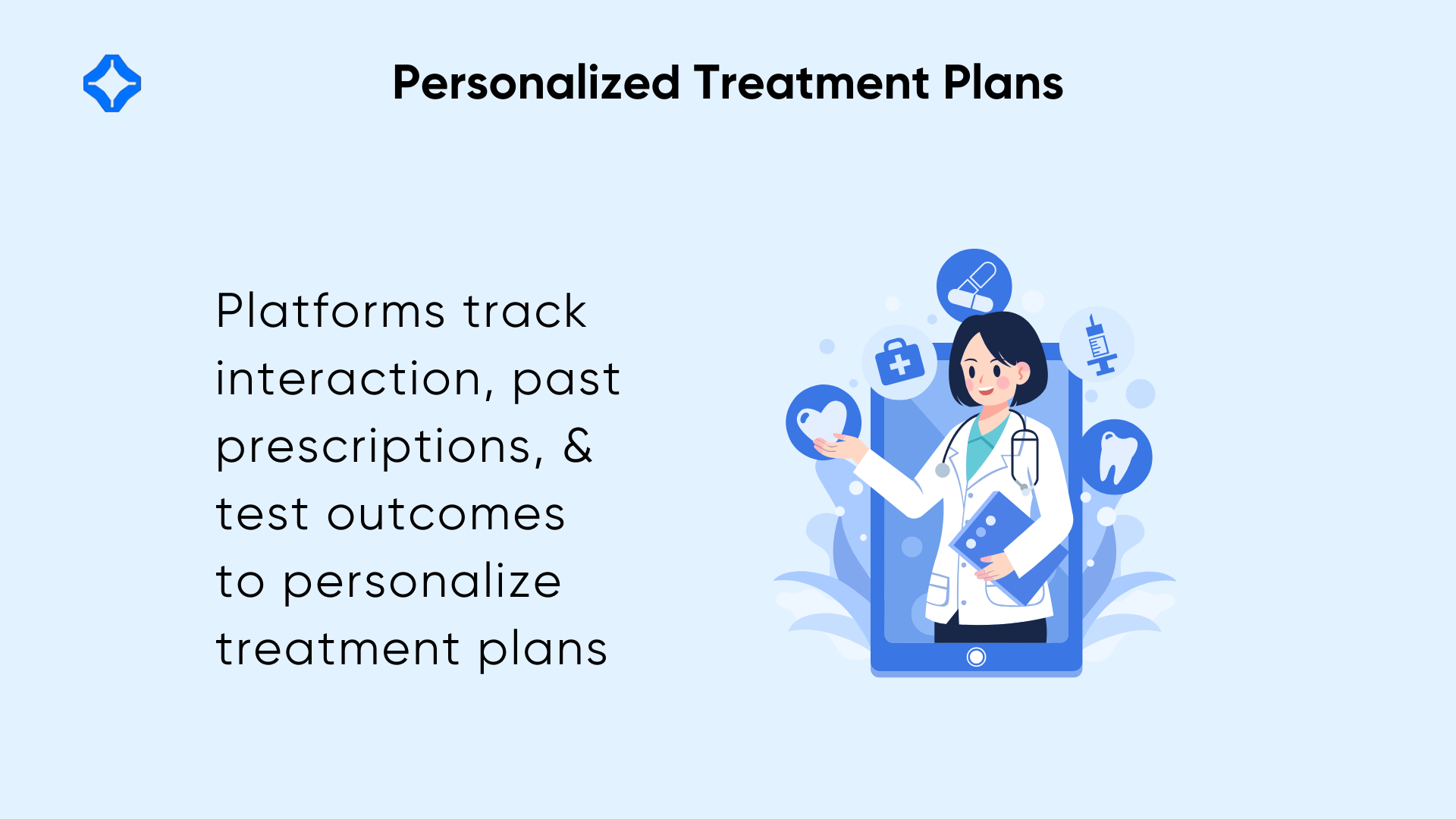Telemedicine SaaS delivers healthcare consultation services through secure, cloud-based platforms. It helps doctors and patients meet remotely, share information, and handle routine tasks. This technology also cuts wait times, lowers travel costs, and speeds up prescriptions.
Many clinics now see its potential to streamline patient care and keep medical data safe. Below, we explore how these solutions shape modern healthcare, improving connections between providers and individuals.

Why Doctor-Patient Connectivity Matters
Clear doctor-patient communication improves treatment effectiveness. When people understand their condition, they follow medical advice better. Telemedicine bridges gaps that appear due to distance or busy schedules.
Strong Communication and Better Outcomes
Quick conversations prevent health problems from getting severe. A simple video call can catch early warning signs. This approach also encourages patients to ask follow-up questions without waiting until their next in-person visit.
Bridging the Gap for Remote Areas
Many regions do not have enough clinics or specialists. Telemedicine allows people to seek care from faraway doctors without traveling long distances. By removing geographic barriers, it raises the overall standard of healthcare for underserved populations.
Key Features of Telemedicine SaaS Platforms

A good telemedicine platform has strong security, easy scheduling features, and direct integration with pharmacy systems. These core features shape the entire patient care experience.
Secure Video Consultations
Secure video calls let patients discuss concerns from anywhere with internet access. Encryption ensures that sensitive health details remain private. Doctors can assess visible symptoms, read facial expressions, and suggest further tests.
These sessions remove the inconvenience of waiting rooms. They also let patients connect with specialists who may not practice locally. For doctors, scheduling becomes easier because they can manage many virtual appointments without extra travel.
Virtual Appointment Scheduling
Online booking simplifies appointment management for both staff and patients. Individuals can pick a slot that fits their day, view available doctors, or cancel sessions if needed. This system lowers scheduling conflicts that often arise with paper-based calendars.
Less manual work frees staff for more difficult duties. Plus, patients appreciate the control. They do not have to call multiple times to confirm or change a booking. Everything updates in real time across the SaaS platform.
E-Prescriptions and Digital Pharmacy Integration
Electronic prescription tools cut the time patients spend waiting for medication. Once the doctor finalizes a prescription, it goes directly to a preferred pharmacy. This automated approach avoids the errors common with handwritten notes.
Access to a digital pharmacy list also helps doctors check stock levels and pricing. Patients learn when their medicine is ready, and they can verify costs before pickup. This workflow speeds up treatment and keeps the process transparent.
Seamless Integration with Electronic Health Records (EHR)
Many clinics use EHR systems to track patient histories. A good telemedicine solution connects with these databases in real time. Doctors update records during virtual consultations. Lab results, notes, and treatment plans stay organized in a single platform.
This integration reduces paperwork and task repetition. Patients no longer need to repeat the same background information for every visit. Doctors have an up-to-date profile of past ailments and medications, which helps them suggest accurate treatments.
Automated Patient Reminders and Follow-Ups
Many appointments go to waste because people forget their schedules. Automated reminders address this issue with timely notifications via email or text. Patients get alerts about upcoming visits, test deadlines, or recommended follow-ups.
Providers can set intervals for check-ins to monitor ongoing conditions. This continuous interaction improves compliance. When people are reminded to attend visits or refill prescriptions, they often see better health results.
Enhancing Accessibility and Convenience
Telemedicine platforms remove several traditional barriers. People who travel far or have multiple responsibilities find it simpler to maintain their regular routines.
Overcoming Distance Barriers
Remote patients once had few options for specialized care. Now, they can book appointments with top specialists from afar. This connectivity saves them hours of travel, lodging expenses, or the inconvenience of leaving work.
Clinics that adopt telemedicine also widen their patient base. They can serve rural communities and partner with local organizations. Everyone gains when physical distances lose their significance in healthcare.
24/7 Availability for Consultations
Telemedicine does not confine healthcare to standard business hours. People can schedule sessions during evenings or weekends. This flexibility is ideal for those who cannot leave work or who have tight deadlines.
Non-emergency issues no longer need an ER visit if a teleconsultation can handle them. Doctors can answer common questions, prescribe minor treatments, or advise on the next steps. Patients see healthcare as more approachable when it fits their daily routine.
Faster Access to Treatment
An online video call can address concerns in minutes, not days. If a patient presents clear signs of infection, the doctor can send e-prescriptions right away. Delays in treatment sometimes lead to complications, so timely care proves essential.
Quick responses also increase patient trust. People feel that their provider prioritizes them. This confidence builds loyalty, encouraging long-term relationships between clinicians and their patients.
Improving Patient Engagement and Satisfaction
When patients stay informed, they participate actively in their treatment. Telemedicine tools encourage frequent touchpoints that help them feel heard.
Better Communication Between Doctors and Patients
Video calls, messaging, and reminders keep conversations flowing. This approach differs from traditional systems that rely on brief face-to-face visits. Patients can ask follow-up questions, clarify medication usage, or share updates on symptoms.
Two-way dialogue matters, especially for chronic illnesses. By discussing concerns sooner, individuals gain confidence in their care. Doctors appreciate these insights, too, because they can adjust treatment quickly.
Personalized Treatment Plans

Telemedicine SaaS uses data analysis to refine care. Platforms might track vitals, past prescriptions, and test outcomes to tailor interventions. This personalization ensures patients get therapies aligned with their unique profiles.
Doctors can tweak drug regimens or diets as needed. They view progress without requiring the person to visit a clinic repeatedly. That convenience motivates patients to stick to their plan and attend check-ins.
Empowering Patients with Self-Care Tools
Online portals grant patients easy access to their health records. They can review lab results or read doctor notes anytime. This visibility decreases confusion about diagnoses or prescribed steps.
Self-reporting tools let individuals log symptoms, track blood pressure, or monitor sugar levels. If any abnormal trends appear, the system flags unusual changes. By seeing immediate feedback, patients take more ownership of their health.
Streamlining Clinical Workflows
Telemedicine SaaS can transform how clinics handle administrative tasks. Appointments, billing, and data management become smoother, leaving more time for patient interaction.
Efficient Appointment and Billing Management
Most telemedicine platforms feature scheduling modules that sync with billing. When a patient confirms a session, the system updates payment details or insurance requirements. Staff can avoid using multiple spreadsheets or phone calls.
By adopting workflow automation within telemedicine platforms, clinics can unify appointment scheduling, billing, and data management under one streamlined system. Speedier processes mean reduced delays in reimbursements. Clinics reduce overhead costs by minimizing paper records. In turn, saved funds can be allocated to medical equipment or staff training.
Improving Prescription Accuracy with Digital Solutions
Mistakes with medicine dosing can be a serious issue. Digital tools eliminate messy handwriting and store each drug’s details in a secure database. Automatic checks compare the chosen medication against known allergies or existing prescriptions.
This integrated approach lowers the odds of harmful drug interactions. Doctors can confirm correct doses quickly and encourage trust in the prescribing process.
Data Analytics for Better Decision-Making
Telemedicine SaaS systems can include dashboards that summarize patient outcomes. They highlight patterns, like spikes in blood pressure or recurring complications. AI helps interpret these data points to suggest the next steps.
Clinics use these insights to adjust their services. For example, if data shows many missed appointments among certain groups, staff might adopt specific outreach strategies. This continuous feedback loop refines care at every level.
Challenges in Telemedicine Adoption
Though telemedicine grows steadily, it faces challenges. Security, tech readiness, and user comfort can all affect successful implementation.
Ensuring Security and Compliance
Healthcare data is sensitive, and breaches are costly. SaaS providers must protect stored information with encryption and secure hosting. Compliance with HIPAA or GDPR means managing patient data lawfully and transparently.
Data Endpoints also need protection, including personal devices used by doctors or patients. Training staff on safe login practices helps minimize unauthorized access. To meet privacy regulations, SaaS cloud security measures must include robust encryption and routine audits of medical data.
Managing Digital Literacy and Accessibility
Not everyone finds online systems easy to use. Older adults or people in low-internet regions might struggle to use these platforms. Simplified interfaces, video tutorials, and how-to guides improve adoption.
Clinics can also offer tech support for new patients. This extra step develops trust and ensures no one is left out. Some solutions feature offline modes, letting individuals connect even with unreliable networks.
Reducing Technical Glitches in Video Consultations
Stable, high-quality video is crucial for accurate diagnoses. If calls drop or audio lags, medical advice might suffer. Telemedicine SaaS providers often rely on cloud-based servers to keep sessions smooth.
AI-driven network monitoring can prioritize audio or video packets, preventing disruptions. Clinics should verify their bandwidth before launching large-scale telehealth options.
Future Trends in Telemedicine SaaS
Telemedicine continues evolving with new ideas and devices. Upcoming trends could further integrate remote care into daily life.
AI-Powered Chatbots for Virtual Assistant
Some AI chatbots chatbots can handle routine queries, like scheduling or symptom checks. They interpret patient descriptions and guide them toward the correct doctor or self-care steps.
This automated layer reduces the workload on clinics during busy hours. It also speeds up minor question handling so doctors can focus on more challenging cases.
Expanding Remote Patient Monitoring
Wearables track real-time vitals, such as heart rate or blood oxygen levels. Telemedicine SaaS pulls that data for ongoing reviews. Doctors can spot warning signs before issues worsen.
Chronic disease management has become more dedicated by telemedicine. Patients gain confidence because they know their doctor receives updates if something goes wrong.
Interoperability Across Healthcare Systems
Sharing data among hospitals, pharmacies, and insurers remains a challenge. More robust interoperability could let patient records travel smoothly between providers. This seamless flow avoids duplicate tests or conflicting medications.
Better collaboration also supports referrals. If a specialist needs previous test results, the system can deliver them instantly. The patient avoids re-explaining their health background multiple times.
Conclusion
Telemedicine SaaS is reshaping how doctors connect with patients. It breaks distance barriers, allows flexible scheduling, and holds all medical data in one secure place. These tools also cultivate deeper engagement, since patients can see their records, track progress, and get reminders.
Healthcare providers that adopt telemedicine can keep pace with modern needs. They see fewer administrative slowdowns, reduce overhead, and maintain stronger patient relationships. By bridging online tools with medical expertise, clinics deliver timely, personalized care. This model paves the way for safer, more efficient healthcare in a rapidly changing world.
FAQs
A telemedicine SaaS (Software as a Service) solution is a cloud-based platform that enables virtual healthcare services. It helps doctors and patients to connect remotely via video calls, chat, and secure data sharing.
Telemedicine platforms offer real-time video consultations, secure messaging, and digital records, making communication faster, more efficient, and more accessible.
Patients benefit from reduced travel time, convenient access to specialists, faster appointment scheduling, and real-time health monitoring.
Doctors can manage appointments efficiently, access patient history instantly, automate follow-ups, and expand their reach to more patients without geographic limitations.